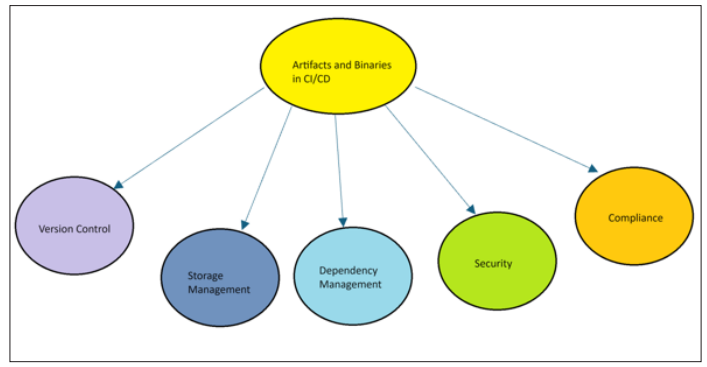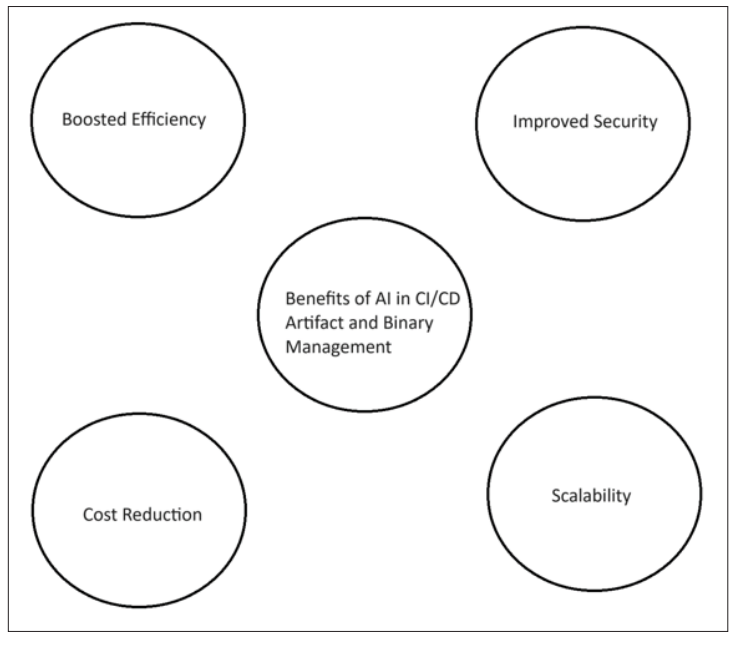Author(s): Amarjot Singh Dhaliwal
In contemporary software development, Continuous Integration (CI) and Continuous Deployment (CD) have become essential practices for boosting productivity, ensuring high code quality, and accelerating delivery times. With the rising complexity of software projects, effectively managing artifacts and binaries within the CI/CD pipeline is increasingly important. Leveraging Artificial Intelligence (AI) has proven to be a game-changer in this domain, as it can significantly enhance the efficiency, accuracy, and reliability of these processes. This paper delves into the role of AI in optimizing the management of artifacts and binaries in CI/CD pipelines, examining the numerous benefits, addressing potential challenges, and considering future prospects in this evolving field.
CI/CD pipelines are fundamental to DevOps methodologies, providing a streamlined approach for teams to automate code integration, testing, and application deployment. Within these pipelines, artifacts and binaries—which are the compiled, built, or packaged versions of the source code-are crucial elements. Proper management of these components is essential for ensuring seamless transitions from development to production, expediting deployment times, and minimizing errors.
The incorporation of Artificial Intelligence into CI/CD pipelines brings transformative possibilities. AI's capabilities in pattern recognition, predictive analytics, and automation can significantly enhance the management of artifacts and binaries. By utilizing AI, organizations can achieve more efficient, reliable, and faster software delivery, thereby bolstering the overall robustness of their CI/CD processes.
In the realm of CI/CD pipelines, artifacts and binaries play an essential role. These components encompass compiled executables, libraries, configuration files, container images, among others. Effectively managing these elements requires meticulous attention to versioning, storage, retrieval, and deployment processes. Each of these steps introduces its own set of complexities and potential pitfalls, making robust management practices critical for ensuring smooth and reliable software delivery.
Managing artifacts and binaries involves several significant challenges:

AI can tackle these challenges by offering smart solutions that automate and enhance multiple facets of artifact and binary management. By leveraging advanced algorithms, AI can streamline processes, reduce manual intervention, and optimize the overall management system. This results in increased efficiency, better resource utilization, and improved accuracy in handling artifacts and binaries.
A significant use of artificial intelligence in Continuous Integration and Continuous Deployment (CI/CD) pipelines is the automated versioning and tagging of software artifacts. Traditional methods often depend on manual tagging, which can be error-prone and inconsistent. By leveraging AI algorithms, the system can analyze code modifications and autonomously create version tags according to set guidelines or learned patterns. This approach guarantees uniform and precise versioning throughout the entire pipeline, thereby enhancing the reliability and efficiency of the software development process.
Artificial intelligence has the capability to anticipate which sections of the codebase are most prone to modifications and identify the dependencies that will be impacted. Through the analysis of historical build data and past code alterations, AI models can enhance the efficiency of the build process. This optimization reduces the frequency of unnecessary builds, thereby speeding up the development pipeline. By adopting this predictive method, it is possible to significantly decrease build times and lower the consumption of resources.
Effective storage management is essential for managing extensive collections of artifacts. Artificial Intelligence (AI) has the capability to examine usage trends and forecast storage needs, facilitating the dynamic distribution of storage resources. Furthermore, AI can automate the process of removing outdated or unused artifacts, ensuring that storage space is utilized efficiently and remains organized. By leveraging AI, organizations can maintain optimal storage conditions, reduce waste, and improve overall operational efficiency.
Handling dependencies in a CI/CD pipeline can be quite challenging, particularly for large-scale projects that involve numerous dependencies. Artificial intelligence can streamline this process by automating the resolution of dependencies. It achieves this by examining the dependency graph to pinpoint the best versions and configurations to use. This automation helps mitigate the risk of dependency conflicts, ultimately ensuring a more seamless and efficient build process. Through AI's analysis, teams can focus on other critical tasks while maintaining a robust and conflict-free environment for their continuous integration and delivery pipelines.
AI-driven security solutions can scrutinize artifacts to identify vulnerabilities and ensure compliance with regulatory standards. Leveraging machine learning algorithms, these tools can detect anomalies and potential security threats in real-time, allowing for proactive measures to mitigate risks. Additionally, AI can automate the process of verifying artifacts against both regulatory requirements and internal organizational policies, ensuring consistent and thorough compliance enforcement.
Artificial intelligence can enhance deployment strategies by examining past deployment data and performance indicators. Utilizing machine learning algorithms, it can suggest optimal deployment times, methods such as canary releases and blue- green deployments, and effective rollback plans. This approach ensures minimal disruption to services and maximizes overall system reliability. Through continuous learning and adaptation, AI- driven deployment strategies can dynamically adjust to changing conditions, providing a robust and efficient deployment process.
Artificial Intelligence streamlines repetitive and time-intensive tasks, allowing human resources to focus on more strategic activities. This results in quicker build and deployment cycles, significantly speeding up the overall software delivery process.
AI’s capability to detect anomalies and vulnerabilities in real- time significantly boosts the security of artifacts and binaries. Implementing proactive security measures helps prevent potential threats and ensures adherence to compliance standards.
AI optimizes build processes and resource utilization, leading to reduced infrastructure costs. Additionally, efficient storage management and the use of predictive analytics contribute further to overall cost savings.
AI-driven solutions can effortlessly scale alongside project growth, managing increasing volumes of artifacts and binaries while maintaining performance and reliability standards.

The success of AI models heavily relies on the caliber of the data used during training. Poor-quality data, whether it be inaccurate or incomplete, can result in less effective outcomes. Therefore, maintaining high-quality data is essential for the effective deployment of AI solutions.
Integrating AI solutions into existing Continuous Integration/ Continuous Deployment (CI/CD) pipelines is often a challenging task. This process demands meticulous planning and coordination to ensure that the integration is smooth and does not interfere with current operations.
The implementation and management of AI-driven solutions require specialized knowledge in artificial intelligence and machine learning. Organizations must invest in the training and recruitment of individuals with the requisite expertise to handle these advanced technologies.
When incorporating AI-driven automation into CI/CD pipelines, it is critical to address ethical issues, such as data privacy and potential biases in machine learning models. Ensuring transparency and accountability in AI processes is vital to uphold ethical standards.
The utilization of artificial intelligence in the management of artifacts and binaries within CI/CD pipelines is rapidly advancing. As AI technology continues to evolve, we can anticipate significant enhancements in efficiency, accuracy, and security. Here are some potential developments we might see in the near future:
By leveraging these advancements, organizations can expect to achieve a more streamlined, secure, and efficient CI/CD pipeline, ultimately leading to faster and more reliable software delivery.
Artificial Intelligence holds immense promise for transforming the management of artifacts and binaries within Continuous Integration/Continuous Deployment (CI/CD) pipelines. Through the automation and optimization of critical processes, AI can significantly enhance efficiency, accuracy, security, and scalability in software development workflows. Despite the challenges and considerations that need to be addressed, the advantages of AI- driven solutions are substantial. As AI technologies continue to evolve, their influence on CI/CD pipelines is expected to expand, resulting in more robust, reliable, and accelerated software delivery processes. Organizations that integrate AI into their CI/ CD strategies will be better equipped to maintain a competitive edge in the fast-paced and ever-changing landscape of software development [1-5].
